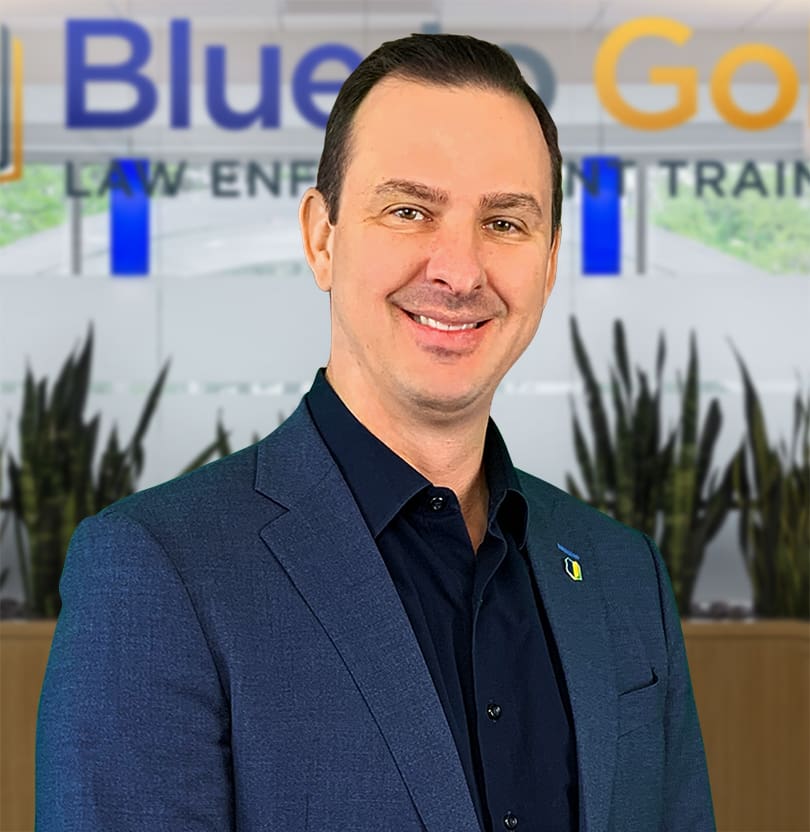Module One: Course Introductions
1. Instructor introduction.
2. Explain the course objective.
3. Encourage attendees to ask questions and share feedback with other attendees.
4. Explain that certificates will be emailed after the class.
5. Go over the three disclaimers:
- a) Laws and agency standard operating procedures may be more restrictive. Blue to Gold is teaching the federal standard unless otherwise stated. Therefore, students must know their state and local requirements in addition to the federal standard.
- b) If students have any doubts about their actions, ask a supervisor or legal advisor.
- c) The course is not legal advice, but legal education. Therefore, nothing we teach should be interpreted as legal advice. Check with your agency’s legal advisor for legal advice.
Module Two: Aspire to be Confident Not Cocky
1. The right of the people to be secure in their persons, houses, papers, and effects, against unreasonable searches and seizures, shall not be violated, and…No Warrants shall issue, but upon probable cause, supported by Oath or affirmation, and particularly describing the place to be searched, and the persons or things to be seized. The Fourth Amendment
2.
3. Legal Rule: It may take up to 10,000 hours of “deliberate practice” to become an expert.
4. Pro Tip: A search and seizure expert has three characteristics:
- Constantly reads case law
- Knows facts matter
- Develops an intuition for “reasonableness”
5.
6.
7. Pro Tip: The goal is to understand the facts and the reason why the court made its decision – don’t get stuck in the weeds.
Module Three: Three Golden Rules
1. Pro Tip: These Golden Rules are intended to help cops stay out of trouble and make good case law Teach them every time!
2. Rule One: The more you articulate why you did something, the more likely it will be upheld in court.
3. Rule Two: The more serious the crime, the more reasonable your actions are likely to be viewed.
4. Rule Three: Conduct all warrantless searches and seizure in the same manner as if you had a warrant.
Module Four: Fourth Amendment Analysis
1. Question One: Who did the search or seizure?
2. Legal Rule: Teach students that private searches are not government searches and evidence can be used even if it would have violated the Fourth Amendment
3.
4. Casino security illegally searched patron and found cocaine. Admissible? Requirements of Casino Control Act that casino establish detailed security procedure did not establish “state action” such as rendered illegal search of defendant and seizure from him of cocaine, even though defendant, who was suspected by casino personnel of being card counter, was unlawfully ejected from casino premises after being unlawfully taken to casino holding room and searched. (State v. Sanders)
5. Case Sample: The facts are culled from the testimony elicited at the suppression hearing. Florida resident Jasmine Hanson was staying at the Crystal Inn motel in Neptune City, New Jersey. She called the front desk to complain she had been bitten by bed bugs and demanded a full refund. She was referred to the motel’s owner. Later that afternoon, the motel owner inspected Hanson’s room. When no one answered his knocks, he entered her room using his pass key. In search of bed bugs, the motel owner pulled a bed comforter down, revealing a plastic bag containing what he suspected were narcotics. The motel owner called the police and reported his suspicion. Upon his arrival, Officer Jason Rademacher had the motel owner lead him to Hanson’s room where, again using his pass key, the motel owner unlocked the door for the officer to enter. Inside, Rademacher saw a clear plastic bag containing what appeared to him to be two other clear plastic bags of crack cocaine and several small glassine bags of heroin. Nearby, the officer saw a jar of what he suspected was synthetic marijuana on the nightstand and a glass measuring cup containing a spoon and a white, rock-like substance in a drawer. Next to the measuring cup was a black scale dusted with a white powder. Rademacher contacted his supervisor, who sent Sergeant William Kirchner to the motel as backup. The officer requested a criminal history check on Hanson. It revealed an outstanding traffic warrant and a recently issued traffic summons on a 2012 black Chevrolet Tahoe, and its plate number. Rademacher collected all the drug evidence and photographed Hanson’s motel room. (State v. Shaw)
6. Question Two: Was it a protected area?
7 . Legal Rule: Teach students that the Fourth Amendment protects certain people, things, and places. Two big exceptions are open fields and abandoned property.
8.
9 . Content: A person’s body and their clothes is highly protected, and police must use caution before going “hand’s on.” Illegal persons, in general, receive the same protections, especially during typical police confrontations.
Key points: Person’s include their bodies and clothes. Content: Houses includes apartments, hotel rooms, garages, business offices, and warehouses.
Key points: Almost every physical structure, unless abandoned, is protected by the Fourth. Activity that is “private, “intimate,” or “familial” is more protected than commercial areas.
Content: Effects include automobiles, cell phones, luggage and so forth. It includes most personal property but not every
piece of real property. For example, not all real estate is covered by the Fourth or property that is disclosed “to the world.”
Key points: The Fourth covers effects, but usually only those where the person has a reasonable expectation of privacy.
10. Pro Tip: Essentially everything has some Fourth Amendment protection except abandoned property and open fields
11. Question Three: Did a search and seizure occur?
12. Legal Rule: Teach students the two types of searches under the Fourth Amendment.
13.
14.
15. United States v. Jones, 565 U.S. 400, was a landmark United States Supreme Court case which held that installing a Global Positioning System tracking device on a vehicle and using the device to monitor the vehicle’s movements constitutes a search under the Fourth Amendment.
16. What would you do? If police fly a drone above a public park and see a stolen car in someone’s backyard, does this violate privacy?
17. What would you do? If police fly a drone above a public park and use magnification to see inside a kitchen window and see contraband, does this violate privacy?
18. Case Sample: United States v. Jones, 565 U.S. 400, was a landmark United States Supreme Court case which held that installing a Global Positioning System tracking device on a vehicle and using the device to monitor the vehicle’s movements constitutes a search under the Fourth Amendment.
19.
20. Case Sample: “The Wobbling Tire” United States v. Richmond 5th Cir. February 8, 2019In the first Broadcast BLUE podcast of the 2019 season, retired FLETC Senior Legal Instructor Bruce-Alan Barnard summarizes and analyzes the case US v Richmond. This is a significant decision because it applies the definition of a search established by the Supreme Court in United States v. Jones (Jan 2012) to an automobile on the side of a highway. Jennifer Lynn Richmond from Tucson, AZ 15 pounds of heroin, 61 pounds of meth worth 7 million.
21. Legal Rule: Physical seizure occurs when you prevent someone’s freedom. Your intentions do matter! Accidental seizures may result in civil liability, but not a constitutional violation.
22. Video: “Empire State Building Shooting”. Synopsis: On Friday, August 24, 2012, at approximately 9:03 a.m. EDT, at the 33rd Street side of the Empire State Building, Jeffrey Johnson, a clothing designer who had been laid off, emerged from hiding behind a van, pointed a .45-caliber semiautomatic handgun at a former co-worker’s head, and fired one round. Once the victim fell to the ground, Johnson stood over him and fired at him four more times, killing him. A coworker of the victim said she witnessed Johnson walk up to him and pull a gun out of his jacket. After the shooting, Johnson concealed the handgun in a briefcase he was carrying, while pedestrians in the vicinity of the site of the shooting screamed and panicked. A construction worker followed him east on 33rd Street then north on Fifth Street and alerted police officers who were stationed in front of the Empire State Building’s Fifth Avenue entrance. When confronted by the two officers, Johnson raised his weapon, but did not fire. The officers fired with a total of 16 rounds, killing Johnson and injuring nine bystanders, none of whom suffered life-threatening wounds. Three of the bystanders were directly hit by police gunfire, while the rest of the injuries were caused by fragments of ricocheting bullets, or by debris from other objects hit by police. Johnson’s handgun, which held eight rounds, still had two rounds remaining when he was shot, and extra ammunition was found inside his briefcase. A witness said people at the scene were shouting, “Get down! Get down!” and that the gunfire lasted about fifteen seconds. The victims, five women and four men ranging in age from 20 to 43, were hospitalized at Bellevue Hospital Center, and New York Presbyterian Hospital/Weill Cornell Medical Center. By Friday evening, six of the nine were treated and released from the hospitals.
23.
24.Question Four: Do you have C.R.E.W.?
25. Legal Rule: Finally, students must understand that if their actions implicate the Fourth Amendment, they need a reason! No exceptions.
26. Pro Tip: “That’s the way I was trained,” “I’ve always done it that way,” “I did it as a best-practice,” and “I did it for officer safety” are NOT Fourth Amendment exceptions!
27.
28.
29.
30. Pro Tip: Teach doctrines, not updates
Module Five Analogs
1. Legal Rule: The Fourth Amendment sets the floor, state constitutions and statutes are sometimes more restrictive
2.
3. Pro Tip: Students should understand both standards
Module Six: Thinking Through Analogies
1.
2.
3. On the evening of March 27, 2012, Dennys Rodriguez was stopped by a police officer on a highway near Waterloo, Nebraska, after the officer observed him swerve out of his lane of traffic.[11] When the officer approached the vehicle, he reported an “overwhelming” scent of air-fresheners emanating from the car. After questioning Rodriguez and another passenger in the car, the officer placed a call for backup and conducted a records check on the vehicle’s passenger. The officer handed a warning ticket to Rodriguez, and then proceeded to walk Floyd, his drug detection dog, around the outside of Rodriguez’s vehicle. When the dog indicated the presence of drugs, the officer searched the car and discovered methamphetamine inside the vehicle. The officer reported that approximately seven or eight minutes passed between the time he issued the warning ticket to the time at which the dog indicated the presence of drugs
4. On the tragic morning of January 1, 2002, Elvira Charley shot three of her six children to death with a .22 caliber semi-automatic rifle, as they slept in the Charley family home located on the Navajo Indian Reservation in Klagetoh, Arizona. When the children were dead, Charley covered their bodies with blankets and went to the home of her aunt, Minnie Begay. After visiting with the Begay’s for more than an hour, Charley left, telling those present that she was going home to “check on her kids.”
Charley later returned to the Begay residence with one of her remaining children, and then left again to make phone calls. She first called her estranged husband and told him that she had shot their three older children. After hanging up with her husband, Charley called the police dispatcher and asked for police assistance because, as she said, she had “done something bad.” She gave the dispatcher directions to the Begay residence and asked the dispatcher to send someone quickly.
Charley then went back to the Begay residence and gave her children’s birth certificates to one of her cousins saying, “take care of my kids, here [is] all the information you need.” Charley did not explain why she needed someone to care for her children. When the police arrived, Charley began hugging her relatives, saying, “I’m sorry … I wasn’t strong enough.”
Sergeant Wallace Billie and Peter Lincoln, an Emergency Medical Technician (“EMT”) from the local fire department, were among the government officers dispatched to the Begay residence. Upon his arrival at the Begay home, Sergeant Billie observed Charley crying and hugging another female. Charley then handed Sergeant Billie the keys to her house, stating “that she’d done something very bad, and that she needed [Sergeant Billie] to check on her children.” Charley also told Sergeant Billie that he was “going to have to put [her] away for a long time.”
Several of Charley’s relatives who were present at the Begay residence began asking Sergeant Billie what was going on. Sergeant Billie asked EMT Lincoln to escort Charley from the house so that Sergeant Billie could talk to Charley’s relatives and explain what was happening.
While waiting for Sergeant Billie outside the Begay residence, Charley initiated a conversation with EMT Lincoln, whom she had known in a personal capacity for about twenty years. Charley addressed EMT Lincoln as “Peter” and volunteered that she had done “something very bad.” Charley further told EMT Lincoln that she had killed her children and that the bodies were still at her house.
When Sergeant Billie came out to his patrol car, he told Charley, “You’re not under arrest. You’re being detained. I need to take you to your house and find out what’s going on.” She replied, “You’re going to have to take me away for a long time.” Sergeant Billie placed Charley in the patrol car, and she gave him directions to her house. When Sergeant Billie asked for permission to enter Charley’s house, Charley responded, “Yes,” urging him to hurry because the children were inside.
After finding the lifeless bodies of three of Charley’s children inside the house, Sergeant Billie secured the scene, and proceeded to question Charley as she sat in his patrol car. The district court found that Charley received Miranda warnings before the interrogation began and that Charley “knowingly and voluntarily waived her rights and made statements” to Sergeant Billie.
5. State v. Waldschmidt, rev. denied 242 Kan. 905 (1987), the Kansas Court of Appeals held that a fenced back yard was within the curtilage. In that case, the court noted the yard was behind and immediately adjacent to the residence and was surrounded by a six foot high wooden privacy fence which obstructed the view of the yard. The court found the fence was of the type used for intimate family activities and by erecting it, the defendant exhibited a subjective expectation of privacy that society will protect as reasonable. Thus, when a law enforcement officer scaled the fence, placed his arm and flashlight over the fence, and observed marijuana plants, the court suppressed the plants as the product of an unconstitutional warrantless search.
Where defendant’s residence was located one-eighth mile from the public road, along a private drive, and house and yard were enclosed in part by a stone wall with a wire gate, the yard area was protected from unreasonable searches and seizures and warrantless seizure of spent rifle shell from the yard the day after defendant’s husband was shot in the yard was unreasonable; seriousness of the homicide investigation did not create exigent circumstances.
6. Videos
Module Seven Takeaways
1.












